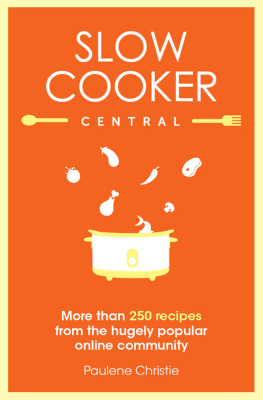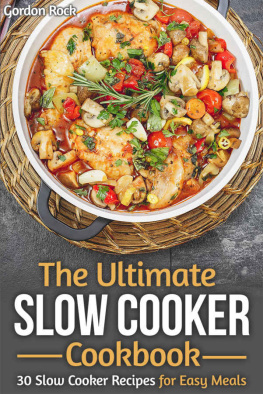A TASTE OF HOME/READERS DIGEST BOOK 2015 RDA Enthusiast Brands, LLC 1610 N. 2nd St., Suite 102, Milwaukee WI 53212-3906 All rights reserved. Taste of Home and Readers Digest are registered trademarks of The Readers Digest Association, Inc. EDITORIAL Editor-in-Chief: Catherine Cassidy Creative Director: Howard Greenberg Editorial Operations Director: Kerri Balliet Managing Editor, Print & Digital Books: Mark Hagen Associate Creative Director: Edwin Robles Jr. Editor: Michelle Rozumalski Associate Editor: Molly Jasinski Art Director: Maggie Conners Layout Designer: Nancy Novak Editorial Production Manager: Dena Ahlers Copy Chief: Deb Warlaumont Mulvey Copy Editor: Mary C. Hanson Content Operations Manager: Colleen King Content Operations Assistant: Shannon Stroud Executive Assistant: Marie Brannon Chief Food Editor: Karen Berner Food Editors: James Schend; Peggy Woodward, RD Recipe Editors: Mary King; Jenni Sharp, RD; Irene Yeh Test Kitchen & Food Styling Manager: Sarah Thompson Test Cooks: Nicholas Iverson (lead), Matthew Hass, Lauren Knoelke Food Stylists: Kathryn Conrad (senior), Leah Rekau, Shannon Roum Prep Cooks: Megumi Garcia, Melissa Hansen, Bethany Van Jacobson, Sara Wirtz Photography Director: Stephanie Marchese Photographers: Dan Roberts, Jim Wieland Photographer/Set Stylist: Grace Natoli Sheldon Set Stylists: Stacey Genaw, Melissa Haberman, Dee Dee Jacq Photo Studio Assistant: Ester Robards Editorial Business Manager: Kristy Martin Editorial Business Associate: Samantha Lea Stoeger BUSINESS General Manager, Taste of Home Cooking School: Erin Puariea THE READERS DIGEST ASSOCIATION, INC.
President and Chief Executive Officer: Bonnie Kintzer Chief Financial Officer: Colette Chestnut Vice President, Chief Operating Officer, North America: Howard Halligan Vice President, Enthusiast Brands, Books & Retail: Harold Clarke Chief Marketing Officer: Leslie Dukker Doty Vice President, North American Human Resources: Phyllis E. Gebhardt, SPHR Vice President, Brand Marketing: Beth Gorry Vice President, Global Communications: Susan Russ Vice President, Chief Technology Officer: Aneel Tejwaney Vice President, Consumer Marketing Planning: Jim Woods For other Taste of Home books and products, visit tasteofhome.com. For more Readers Digest products and information, visit rd.com (in the United States) or rd.ca (in Canada). International Standard Book Number (Epub): 978-1-61765-346-3 Pictured on cover: Pictured on title page:
Slow Cooking 101
The original slow cooker, called a Crock-Pot, was introduced in 1971 by Rival. Today, the term slow cooker and the name Crock-Pot are often used interchangeably; however, Crock-Pot is a brand, and a slow cooker is the appliance. Most slow cookers have two or more settings.
Food cooks faster on the high setting, but the low setting is ideal for all-day cooking or for less tender cuts of meat. Use the warm setting to keep food hot until its ready to serve. The slow cooker recipes in this book refer to cooking on either high or low settings. Some newer slow cookers seem to heat up faster than older ones. If you have an older model and a recipe directs to cook on low, you may want to set the slow cooker on the highest setting for the first hour of cooking to be sure the food is thoroughly cooked.
When Using Your Slow Cooker
Slow cookers come in a range of sizes, from 1 1/2 to 7 quarts.
Its important to use the right size for the amount of food youre making. To serve a dip from a buffet, the smallest slow cookers are ideal. For entertaining or potluck dinners, the larger sizes work best. Check the chart below to find a useful size for your household. To cook properly and safely, manufacturers and the USDA recommend slow cookers be filled at least half full but no more than two-thirds full. With many slow cooker recipes, the ingredients are added at once and are cooked all day.
For make-ahead convenience, place the food items in the crock the night before, cover and refrigerate overnight (the removable stoneware insert makes this an easy task). In the morning, place the crock in the slow cooker and select the proper temperature. Do not preheat your slow cooker. An insert that has been in the refrigerator overnight should always be put into a cold base unit. Stoneware is sensitive to dramatic temperature changes, and cracking or breakage could occur if the base is preheated. After the recipe is finished cooking, if there are any leftovers, allow them to cool, then refrigerate.
Slow cookers should not be used to reheat leftovers. Instead, use a microwave, stovetop burner or oven to reheat foods to 165. This ensures that the food has been thoroughly heated and it is safe to eat. Following a power outage of less than two hours, you can finish cooking food from your slow cooker on the stovetop or microwave. If its been more than two hours or you are unsure how long the power has been out, discard the food for your safety.
| Slow Cooker Size |
| HOUSEHOLD SIZE | SLOW COOKER CAPACITY |
| 1 person | 1 1/2 quarts |
| 2 people | 2 to 3 1/2 quarts |
| 3 or 4 people | 3 1/2 to 4 1/2 quarts |
| 4 or 5 people | 4 1/2 to 5 quarts |
| 6 or more people | 5 to 7 quarts |
Converting Recipes for the Slow Cooker Almost any recipe that bakes in the oven or simmers on the stovetop can be easily converted for the slow cooker.
Here are some guidelines. Before converting recipes, check the manufacturers guidelines for your particular slow cooker. Find a recipe that is similar to the one you want to convert and use it as a guide. Note the amount and size of meat and vegetables, heat setting, cooking time and liquid. Since there is no evaporation, adjusting the amount of liquid in your recipe may be necessary. If a recipe calls for 6 to 8 cups of water, try starting with 5 cups.
Conversely, recipes should include at least a little liquid. If a recipe does not include liquid, add 1/2 cup of water or broth. In general, 1 hour of simmering on the stovetop or baking at 350 in the oven is equal to 8-10 hours on low or 4-6 hours on high in a slow cooker. Check the chart below. Flour and cornstarch are often used to thicken soups, stews and sauces that are cooked in a slow cooker. Cook Times 15 to 30 minutes in Conventional Oven Slow Cooker Low: 4 to 6 hours High: 1 1/2 to 2 hours 35 to 45 minutes in Conventional Oven Slow Cooker Low: 6 to 8 hours High: 3 to 4 hours 50 minutes or more in Conventional Oven Slow Cooker Low: 8 to 10 hours High: 4 to 6 hours When a range in cooking time is provided, this accounts for variables such as thickness of meat, how full the slow cooker is and the temperature of the food going into the cooker.
As you become used to how your slow cooker works, youll be better able to judge which end of the range to use. 
Tips for Tasty Outcomes
No peeking! Refrain from lifting the lid while food cooks in the slow cooker, unless a recipe instructs you to stir or add ingredients. The loss of steam can mean an extra 20-30 minutes of cooking time each time you lift the lid. Be sure the lid is well-placed over the ceramic insert, not tilted or askew. The steam during cooking creates a seal. When food is finished cooking, remove it from the slow cooker within one hour and promptly refrigerate any leftovers.









 A TASTE OF HOME/READERS DIGEST BOOK 2015 RDA Enthusiast Brands, LLC 1610 N. 2nd St., Suite 102, Milwaukee WI 53212-3906 All rights reserved. Taste of Home and Readers Digest are registered trademarks of The Readers Digest Association, Inc. EDITORIAL Editor-in-Chief: Catherine Cassidy Creative Director: Howard Greenberg Editorial Operations Director: Kerri Balliet Managing Editor, Print & Digital Books: Mark Hagen Associate Creative Director: Edwin Robles Jr. Editor: Michelle Rozumalski Associate Editor: Molly Jasinski Art Director: Maggie Conners Layout Designer: Nancy Novak Editorial Production Manager: Dena Ahlers Copy Chief: Deb Warlaumont Mulvey Copy Editor: Mary C. Hanson Content Operations Manager: Colleen King Content Operations Assistant: Shannon Stroud Executive Assistant: Marie Brannon Chief Food Editor: Karen Berner Food Editors: James Schend; Peggy Woodward, RD Recipe Editors: Mary King; Jenni Sharp, RD; Irene Yeh Test Kitchen & Food Styling Manager: Sarah Thompson Test Cooks: Nicholas Iverson (lead), Matthew Hass, Lauren Knoelke Food Stylists: Kathryn Conrad (senior), Leah Rekau, Shannon Roum Prep Cooks: Megumi Garcia, Melissa Hansen, Bethany Van Jacobson, Sara Wirtz Photography Director: Stephanie Marchese Photographers: Dan Roberts, Jim Wieland Photographer/Set Stylist: Grace Natoli Sheldon Set Stylists: Stacey Genaw, Melissa Haberman, Dee Dee Jacq Photo Studio Assistant: Ester Robards Editorial Business Manager: Kristy Martin Editorial Business Associate: Samantha Lea Stoeger BUSINESS General Manager, Taste of Home Cooking School: Erin Puariea THE READERS DIGEST ASSOCIATION, INC.
A TASTE OF HOME/READERS DIGEST BOOK 2015 RDA Enthusiast Brands, LLC 1610 N. 2nd St., Suite 102, Milwaukee WI 53212-3906 All rights reserved. Taste of Home and Readers Digest are registered trademarks of The Readers Digest Association, Inc. EDITORIAL Editor-in-Chief: Catherine Cassidy Creative Director: Howard Greenberg Editorial Operations Director: Kerri Balliet Managing Editor, Print & Digital Books: Mark Hagen Associate Creative Director: Edwin Robles Jr. Editor: Michelle Rozumalski Associate Editor: Molly Jasinski Art Director: Maggie Conners Layout Designer: Nancy Novak Editorial Production Manager: Dena Ahlers Copy Chief: Deb Warlaumont Mulvey Copy Editor: Mary C. Hanson Content Operations Manager: Colleen King Content Operations Assistant: Shannon Stroud Executive Assistant: Marie Brannon Chief Food Editor: Karen Berner Food Editors: James Schend; Peggy Woodward, RD Recipe Editors: Mary King; Jenni Sharp, RD; Irene Yeh Test Kitchen & Food Styling Manager: Sarah Thompson Test Cooks: Nicholas Iverson (lead), Matthew Hass, Lauren Knoelke Food Stylists: Kathryn Conrad (senior), Leah Rekau, Shannon Roum Prep Cooks: Megumi Garcia, Melissa Hansen, Bethany Van Jacobson, Sara Wirtz Photography Director: Stephanie Marchese Photographers: Dan Roberts, Jim Wieland Photographer/Set Stylist: Grace Natoli Sheldon Set Stylists: Stacey Genaw, Melissa Haberman, Dee Dee Jacq Photo Studio Assistant: Ester Robards Editorial Business Manager: Kristy Martin Editorial Business Associate: Samantha Lea Stoeger BUSINESS General Manager, Taste of Home Cooking School: Erin Puariea THE READERS DIGEST ASSOCIATION, INC. 
